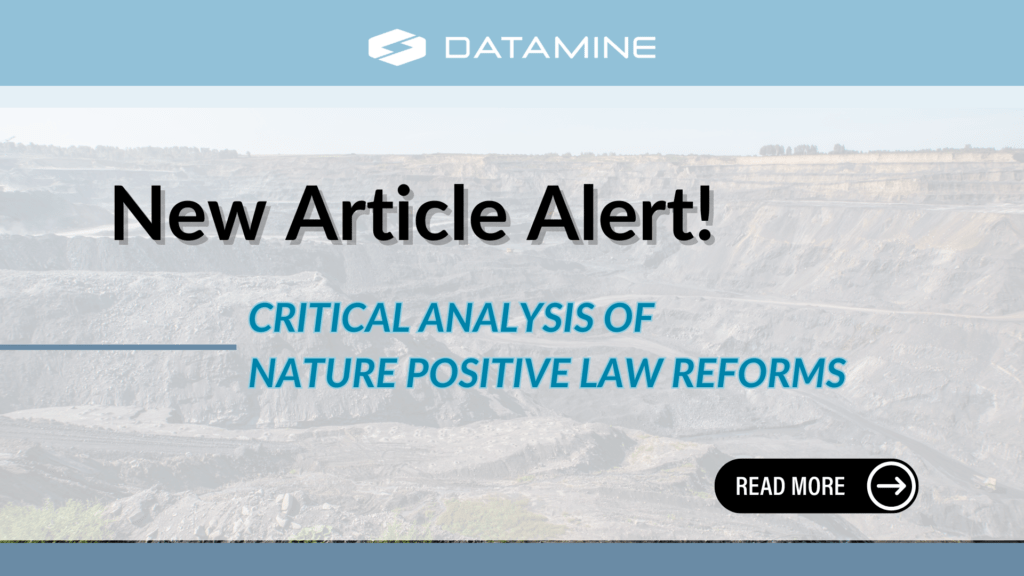Proposed reforms to the EPBC Act.
On 16 April 2024 the Minister for the Environment and Water Tanya Plibersek announced the ‘second stage’ of the Nature Positive reforms. The proposed reforms to the Environment Protection and Biodiversity Conservation (EPBC) Act raise significant concerns about potential duplication with the WA’s Environmental Protection Authority (EPA) processes.
While the reforms claim they will enhance environmental protection, they could introduce unnecessary regulatory requirements which would over-complicate mining operations.
The centre piece of the reform is the National Environmental Standards; heralded to be a positive step, enabling consistency and flexibility across decisions. It’s been suggested that it could provide uniform protection guidelines. We remain sceptical about how effectively the Federal and State regulations will align, fearing that rather than simplifying processes, the lack of clarity will create additional hurdles. Dutton said it is “anti mining and anti development”.
While reforms aim to simplify environmental assessment and approval processes, duplication between the Federal EPBC Act and State EPA processes could lead to increased administrative burdens and elevated costs. With two sets of processes, undoubtedly conflicting requirements and timelines will emerge, potentially causing delays in project approvals.
Instead of streamlining operations, miners worry that the reforms will prolong approval timelines and inflate costs, hindering operational efficiency. Shadow Environment Minister Jonathon Duniam says the penalties in Labor’s Nature Positive Plan will be a “massive deterrent” for investors in Australia.
Implementing these reforms poses further challenges. We anticipate requiring additional resources to manage compliance with both new Federal standards and existing State requirements. This could include significant expenditures on legal, environmental, and administrative support. Smaller mining companies will struggle the most, lacking the resources to handle the increased regulatory load.
Larger operations could also face financial strain, potentially necessitating the hiring of additional consultants to navigate the new regulatory landscape.
Practical implementation of nature-positive principles outlined in the legislation is a major concern. It is defined as “diversity, abundance, resilience and integrity of ecosystems from a baseline”. Sounds simple, but until the last of the legislation is released, stakeholders will not know with certainty what “nature positive” is for future projects.
While the government promises clarity. Ambiguity could complicate compliance and operational planning.
The enhanced requirements for Indigenous engagement and increased transparency mandated by the reforms also present challenges. We anticipate navigating dual consultation processes, potentially leading to extended negotiation periods and additional resource commitments, in addition to the Native Title requirements. Moreover, ensuring compliance with differing State and Federal requirements could prove burdensome, impacting operational decisions.
Scepticism towards the reforms is widespread within the mining industry. Past experiences and political dynamics contribute to concerns about the viability of the proposed changes. We worry that the reforms may not deliver the desired outcomes and could instead create further obstacles to operations. For example; a Pilbara biodiversity plan release for comment was withdrawn for its unacceptable flaws and obstacles that may be created for the industry.
In conclusion, while the proposed EPBC Act reforms aim to enhance environmental protection, they raise significant concerns from the perspective of Western Australian miners. The risk of increased bureaucracy, conflicting requirements, and extended timelines threatens operational efficiency. Achieving effective integration between state and federal processes will be crucial to avoid redundancy and ensure that the mining industry can continue to operate smoothly. Continuous dialogue between industry stakeholders and regulatory bodies is essential to address these concerns and achieve a balanced approach to environmental protection and economic development.
Find out more about environmental policies that affect WA’s mining industry in our Environmental Essentials training course.
Other industry training courses available are:



